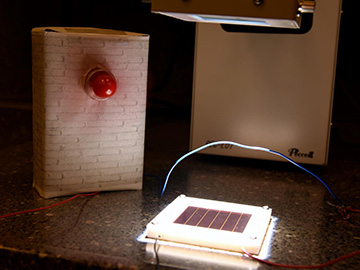
OIST researchers have reported a technique for creating stable, high-efficiency perovskite solar cells and modules (shown here in a test setup) through changes in the material and deposition technique for the electron transport layer. [Image: OIST]
Perovskite photovoltaics (PVs) continue to attract interest and research as a potential low-cost alternative to silicon-based solar cells. But commercializing perovskite PVs will require ways to make them stand up to long-term use—while maintaining acceptable efficiency in real-world modules, which are substantially bigger than the small fragments of optimized material used in lab experiments.
A research team at the Okinawa Institute of Science and Technology (OIST) Graduate University believes it has found one path toward an answer (Adv. Funct. Mater., doi: 10.1002/adfm.201806779). By replacing a key material in the perovskite PV stack, and adapting a common, low-cost thin-film production method, the researchers were able to fashion perovskite solar cells sporting greater than 20 percent efficiency and operating lifetimes more than double those of other comparable perovskite cells. And efficiencies in larger-area modules fashioned using the technique remained potentially competitive with those reported for large-area perovskite modules made through more expensive production processes.
Titanium vs. tin
A perovskite solar cell, in its simplest form, consists of an active perovskite layer sandwiched between a cathode and an electron transport layer (ETL) on one side and a hole transport layer (HTL) and anode on the other. As photons strike the active layer, they kick out negatively charged electrons and create positively charged holes; the ETL and HTL allow these charge carriers to flow through the cell, avoiding recombination and creating an electric field in the cell.
The OIST team focused on the ETL because, previous research suggests, it is here that many of the stability problems in existing perovskite solar cells lie. The most common ETL material, titanium dioxide (TiO2), can indeed create cells with high efficiency ratings. But TiO2 tends to react chemically with the central, active perovskite layer in the presence of sunlight, wearing down the device efficiency and degrading it over a relatively short time. And forming large-area perovskite solar modules with TiO2 as the ETL, according to the team, also requires potentially costly high-temperature processing and “a complicated laser patterning process.”
An alternative ETL candidate is tin dioxide (SnO2), which has been used in small-area cells sporting efficiencies of greater than 21.5 percent, and which can achieve much longer operating lifetimes than cells that include TiO2. SnO2 also promises the capability for low-cost manufacture via sputtering deposition, a technique already in widespread use for creating high-quality thin films. But most demonstrations to date of perovskite PVs using SnO2 ETLs have been small-area solar cells. And even for those small cells, the few thus far created using sputtering deposition have shown unimpressive efficiencies on the order of only 14 percent.
Fine-tuning sputtering deposition
The OIST researchers, led by Yabing Qi, took another look at the prospects for sputtering deposition of SnO2 in perovskite PVs, and at how the process might be tuned and adapted to create ETLs suitable for large-area perovskite solar modules.
In the sputtering-deposition process, a target wafer of SiO2 is bombarded by argon gas atoms, in the presence of oxygen, to eject particles from the solid target; those ejected particles then spray through the sputtering chamber and are deposited onto a target substrate as a thin film. The researchers found that adjusting the ratio of argon and oxygen to make the environment highly oxidized and reactive was one key to making high-quality thin films. They used this factor as a control knob to tune the morphology and surface structure for the SiO2 films.
By leveraging this technique to create high-quality SiO2 ETLs, the OIST team was able to fashion small-area perovskite PVs with efficiencies on the order of 20.2 percent—slightly below the best reported levels for SiO2-containing cells, but still competitive. And they found that the cells’ stability, as measured by the T80 lifetime (the time over which the photoconversion efficiency falls to 80 percent of its initial value) could reach as high as 650 hours, more than twice the level of TiO2-containing cells fashioned using comparable techniques.
Boosting module performance

Lead author Longbin Qiu, examining a sheet of solar cells made from flexible materials. [Image: OIST]
Scaling up small-format, lab-scale perovskite technologies to large-area solar modules inevitably entails a loss of efficiency. The team notes that larger-area perovskite solar modules with an aperture area of 36.1 cm2, even when created using state-of-the-art techniques, have reached reported efficiencies of 12.1 percent. That’s well below the 20-percent-plus efficiencies for the best small-area lab demonstrations of small-area perovskite PVs.
To see how well their cells with SiO2 ETLs would compare in large-area modules, the OIST researchers fabricated a 22.5-cm2 module consisting of six perovskite cells. The module showed an efficiency of slightly more than 12 percent—a bit behind some other demonstrations—but with a greater operating lifetime of T80 = 515 hours.
According to a press release accompanying the research, the researchers are now working on optimizing their solar cell design with an eye toward producing large-scale perovskite solar modules with better efficiency. They’re particularly hoping to use these products to create flexible, transparent applications in solar windows, curtains, backpacks and deployable charging units.
Although the cells’ efficiency “is already reasonable, we want to push it further,” team leader Qi noted in the release. “We are optimistic that in the next few years, this technology will be viable for commercialization.”
